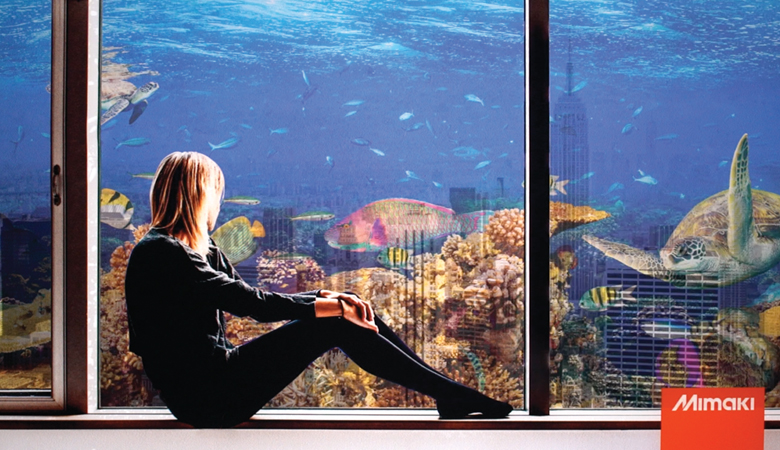Mimaki’s 2D and 3D printers provide dealers with technology to penetrate the sign and display graphics market.
Above: An example of 4-layer printing
All indications point to a resurgence in the sign and display graphics business as retailers reopen after pandemic-related shutdowns. In addition to signage to encourage social distancing and mask-wearing, retailers are looking for intriguing ways to use signs and display graphics to attract customers.
Recent 2D and 3D products from Mimaki offer sign and display graphics firms and the dealers that support them, many unique capabilities for retailers.
Mimaki has operated in the United States for two decades of its 45-year history and has a well-developed dealer network.

Above: Michael Maxwell, senior manager, corporate strategic development, Mimaki USA.
“We look for dealers that are not one-stop shops primarily selling and servicing equipment, but those that are more specialized,” said Michael Maxwell, senior manager, corporate strategic development, Mimaki USA. “Of course, we selfishly would like our dealers to focus only on us, but with any manufacturer, there could be gaps in the portfolio that could be filled elsewhere.”
Mimaki is looking for someone who knows the product and the market and can provide not just technical support but also support the customer’s unique usage of the product. The goal, said Maxwell, is a network of dealers that provide an exceptional customer experience.
“We want end-customers to be confident that they bought the product from someone who knows the product, the materials that will be used, the cleaning solutions they need, and any post-processing that might be required,” observed Maxwell. “A dealer needs to be well-versed in all of that for us to consider them.”
Mimaki serves three primary markets—sign and display graphics, textiles, and industrial.
Maxwell explained that each area has its own requirements and specialized knowledge.
In signs and display graphics, in addition to the equipment, dealers will likely be selling consumables, including vinyl, squeegees, blades, electrical components, and screen-printing materials. In textiles, dealers should understand ancillary equipment requirements such as a heat press or a steam-finishing solution to set the inks. They should also understand the different types of inks and fabrics and how they interact. In industrial, there is often an integration focus that is more software-driven and less consumable based.
“We spend a good deal of time looking at the dealer network and try to keep a good balance of dealers that serve different markets,” said Maxwell.
Two areas where Mimaki distinguishes itself with its signs and display graphics are the unique signage created using its UCJV300 Series and its 3D printing portfolio. The two can also be combined for specialty applications.
Maxwell pointed out that solvent is still a dominant technology in signs and display graphics. Still the demand for UV-curable printing has heated up as companies seek solutions with more durability, a smaller environmental footprint, and a broader range of application capability.

Above: The same 4-layer print as above, backlit.
“Customers like the instant lamination and curing, clear, and white inks, the ability to print on clear substrates, layered print, and more that come with the UCJV300 Series,” stated Maxwell. “Prints are ready to be finished or delivered right out of the printer.”
Layered printing comes in two flavors with the UCJV300 Series: 5-layer printing is a two-sided print that can have different images on each side—open/closed is a good example—and 4-layer printing that shows one image when looking at it from the front, and an entirely different image if the piece is backlit.
“This product has really been a home run for us,” said Maxwell.
3D printing is another area of opportunity for sign and display graphics businesses. Mimaki has three in its portfolio: the 3DFF-222, a desktop printer for in-house production of print jigs and three-dimensional signs; the 3DUJ-553, a full-color UV curable printer that enables modeling in more than 10 million colors, including Pantone colors; and most recently, the 3DGD-1800, a large-scale 3D printer that can produce items as tall as 1.8 meters.
These are unique products that can be used alone or mixed and matched to create items that require both large-scale and smaller components. Maxwell explained some of the differences: “You can start with the 3DUJ-553 full-color printer, which fits well in all kinds of different markets, including medical, dioramas, prototyping, and more. The 3DFF-222 gives our UJF flatbed line a complementary capability to create products that can be directly printed, like USB keys, with the ability to create the necessary jigs. And the 3DGD-1800 is excellent for architectural signage, dimensional signage used in amusement or theme parks, or in the entry to a retail outlet. And it is really powerful when you combine these 3D products with 2D products. For example, you can print something on the 3DGD-1800 and wrap it with vinyl that has been printed on the UCJV300 series, marrying these two technologies for all kinds of unique applications.”
With the 3DGD-1800, larger-scale items are created in pieces for assembly later. The example Maxwell shared was a dinosaur model where you can print the body, the legs, etc., and put in structural members or metal framing, and backfill the item with foam for a strong construction. Or lighting can be placed inside a hollow object.
“There are lots of different and exciting things to do with these products, and imagination is the only limit,” said Maxwell, who sees a bright outlook for signs and display graphics, especially those combining 2D and 3D technologies, as the economy reopens and retail gets busy again.
“It’s great to see how the signage industry has stepped up to help the economy get going,” said Maxwell.
Access Related Content
Visit the www.thecannatareport.com. To become a subscriber, visit www.thecannatareport.com/register or contact cjcannata@cannatareport.com directly. Bulk subscription rates are also available.

